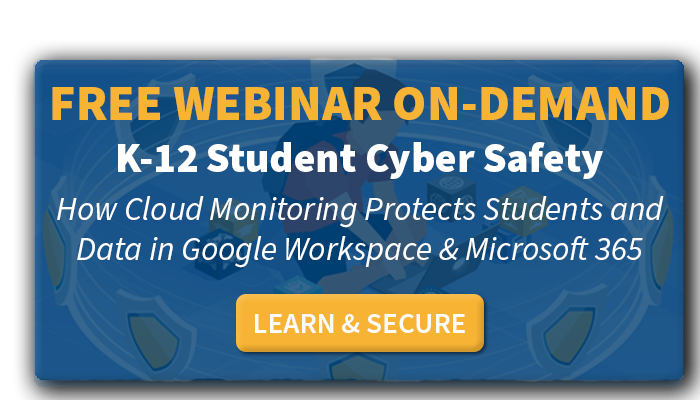Why Cloud Monitoring Is Critical For School Cyber Safety & Security
Cloud monitoring provides you with visibility into what is going on in your district’s cloud applications
According to The State of K-12 Cybersecurity 2020 Year in Review report published by the K12 Security Information Exchange and the K-12 Cybersecurity Resource Center:
“. . . the 2020 calendar year saw a record-breaking number of publicly-disclosed school cyber incidents. Moreover, many of these incidents were significant: resulting in school closures, millions of dollars of stolen taxpayer dollars, and student data breaches directly linked to identity theft and credit fraud.“
The threat to districts from cyber attacks is clear, and it is increasing. But the line between cybersecurity and student safety is still blurred for many district IT teams. K-12 cyber safety and K-12 cybersecurity strategies continue to focus on network and web search monitoring. However, more school data is created and stored in cloud applications like Google Workspace for Education and Microsoft 365. Therefore, it’s critical that districts monitor and secure their cloud apps.
Schools provide cloud applications to students for learning, collaboration, and communication purposes, but students don’t always use those apps for schoolwork. Schools are experiencing greater rates of cybersecurity and safety incidents within their own cloud applications.
Cloud Monitoring for Cyber Safety
Toxic online behavior and student cyber safety have been an issue for schools and their communities for quite some time now. As students become more comfortable with using school technology, they are also becoming more comfortable using it to communicate with each other and to express their own thoughts. For example, students are increasingly using Google Docs to journal their thoughts and feelings.
IT managers are becoming unique allies in enabling administrators with the ability to detect cyber safety signals such as self-harm, suicide, cyberbullying, threats of violence, and more.
There are at least six types of student cyber safety risks:
- Cyberbullying
- Inappropriate and/or explicit content
- Sexting, sextortion, and online predation
- Discriminatory and hate speech
- Threats of violence
- Self-harm and suicide
Cyberbullying is one of the most harmful to students, whether they are the ones doing the bullying or being bullied. Cyberbullying detection is critical because the bullies have problems that need to be resolved. They may use bullying to fit into the crowd or to get attention, but the underlying problems they face include a lack of empathy or an inability to deal with negative emotions.
Research shows that the students being bullied report that it affects their ability to learn and feel safe in school. Targets of bullying also experience mental health issues that can be severe, including social anxiety, depression, suicidal thoughts, self-harm, eating disorders, and drug and alcohol abuse. These types of issues can be long-term and difficult to remedy.
Student suicide is another critical risk because when a student takes their own life, the opportunity to help them is over. Student suicide prevention is another area where IT teams can be the first line of defense to spot suicide signals. IT teams understand self-harm monitoring technology, they have visibility into students behavior online, and they can provide a fast and objective response.
The IT team shouldn’t have an active role in working with students but should turn over information about the signals they see to the district professionals who are tasked with providing counseling. However, it would be a mistake to underestimate the role IT can play in an overall district suicide prevention program.
Cloud Monitoring for Cybersecurity
Phishing, malware, account takeovers, and data breaches have been hitting K-12 schools hard over the past couple of years. And, just in the last year or so, we’re seeing a real increase in awareness of the problem.
Now that many districts are bringing education back into the classroom, district IT security leaders and admins need to thoughtfully plan for how they will bring devices that have been connected to other unmanaged networks for months back into the network. You’ll also need to consider how you will secure sensitive district data going forward if students, teachers, and staff will be able to take school devices home even after school buildings fully reopen.
To borrow an expression from Benjamin Franklin, when it comes to cybersecurity, an ounce of prevention is worth a pound of cure. Districts need to focus on cybersecurity to prevent attacks from occurring. By the time an attack has happened, your district is in a compromised position. Cyber insurance can help you recover, but cyber insurance isn’t a substitute for cybersecurity.
Make sure cloud security fits in your cybersecurity infrastructure. You can use a multi-layered cybersecurity infrastructure to protect data inside and outside of your network. Undoubtedly, you already have one or more tools in your infrastructure because no one solution does everything or does everything well. Your cybersecurity infrastructure needs to cover a variety of things such as identity and access management, endpoint security and network security.
But if you use Google or Microsoft cloud applications, you need to add a cloud security layer to protect your data and your students. Knowing where to start is the challenge for many districts, which is where the framework developed by The National Institute of Standards and Technology (NIST) comes in. You can use the framework to develop your own K-12 NIST Cybersecurity Framework.
Once completed, you’ll have established the five functions that lay the foundation for implementation and are the five pillars you need to succeed. Districts around the country have used the Framework, and states like New Hampshire have passed legislation that requires districts to comply with a subset of the standard.
The post Why Cloud Monitoring Is Critical For School Cyber Safety & Security appeared first on ManagedMethods.
*** This is a Security Bloggers Network syndicated blog from ManagedMethods authored by Alexa Sander. Read the original post at: https://managedmethods.com/blog/cloud-monitoring/

![[FREE WEBINAR] K-12 Student Cyber Safety In Google & Microsoft 365. LEARN & SECURE >>](https://no-cache.hubspot.com/cta/default/6834707/5483003b-2569-44c1-ae3e-5a6fa2761ade.png)





